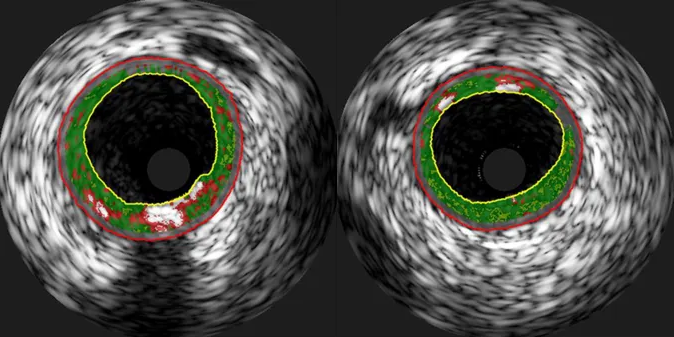Exercise, microRNAs and atherosclerosis – CERG

Does exercise affect microRNA and coronary plaques after a heart attack?
What effect does exercise have on the amount and composition of plaques in the heart's blood vessels in patients who have had a heart attack? And can exercise effects on microRNAs play a role in plaque composition?
PhD project: MikroRNAs, aerobic exercise and coronary plaque composition
Candidate: Maria Dalen Taraldsen

Background
It is known that exercise is good medicine after a heart attack and in other established cardiovascular diseases. We have shown in a previous project that exercise can reduce the amount and change the composition of plaques in the coronary arteries (the blood vessels of the heart) in patients who have been treated for heart attacks and angina pectoris. If these plaques are rich in fat and unstable, they can rupture and lead to another heart attack.
In her PhD, Maria Dalen Taraldsen uses data from the same project to look more specifically at the plaques in patients' stented blood vessels. A stent is inserted into narrow coronary arteries once the plaque has been removed, to prevent the arteries from re-clotting.
Exercise can affect the levels of tiny molecules that regulate the activity of our genes, so-called microRNA molecules. However, this has not been studied in heart patients, and is thus being done for the first time in Maria's PhD. She also investigates connections between micro-RNA and plaque composition, and whether exercise has an effect on these connections.
Interval training reduced plaques most effectively in stented vessels

4x4 interval training after treatment for heart attack or angina can have a greater effect on plaque burden in the stented coronary arteries than moderate intensity exercise. Also, the content of the vulnerable necrotic core in the middle of the plaques was reduced more with interval training in our study. This core of dead tissue is a marker for risk of plaque rupture and a new heart attack. In a previously published article from the same study, we showed that exercise seems to reduce plaques also in the non-stented part of the coronary arteries. However, those analyses found no difference between interval training and moderate exercise.
Thirty-two patients with stable coronary artery disease participated in the study, and were randomly assigned to the two exercise groups. All participants were treated with modern drug-eluting stent implantation before the exercise intervention. We used intravascular ultrasound to examine the stent itself, as well as the 0.5 cm areas outside of both edges of the stent. Only plaques outside the distal stent edge showed favourable changes after the 12-week exercise period. Both exercise groups achieved significant reductions in plaque burden and necrotic core in this area, but the effects were greatest for the high-intensity interval training group.
We have found four micro-RNA molecules that change levels after a period of exercise, and which are also associated with reduced plaque burden in the coronary arteries of heart patients. The results come from a study in which 31 patients either trained intensive intervals or with moderate intensity three days a week after they had opened narrow blood vessels in the heart. We examined their vessels with intravascular ultrasound both before and after the exercise period.
Micro-RNAs are tiny particles that regulate the activity of our genes. Many micro-RNA molecules are involved in various stages of the atherosclerosis process that clog blood vessels and lead to cardiovascular disease. In this study, we pre-defined 13 micro-RNA molecules that we examined further, based on results from previous studies.
After three months of training, the levels of micro-RNA-146a-5p had increased, while the levels of micro-RNA-15a-5p, 93-5p and 451a had decreased. All of these changes were also linked to a reduction in the total amount of plaque in the blood vessels of the patients. The study can not say anything about causation, but we can speculate that exercise leads to changes in micro-RNA that are beneficial in reducing coronary artery plaques in heart patients.
In addition, we found that the levels of six micro-RNA molecules were linked to a larger necrotic core. This plaque core consists of inflammatory cells and fat, and plaques with a lot of fat are more vulnerable to rupture that leads to heart attacks. However, changes in this necrotic core after an exercise period were not related to how micro-RNA levels changed during the same period.
PhD candidate
Researchers who have contributed to articles from the PhD project
-
Anja Bye Professor and head of research group in Cardiogenomics
+4793232057 anja.bye@ntnu.no Department of Circulation and Medical Imaging -
Knut Hegbom St. Olavs hospital
-
Erik Madssen Associate Professor
erik.madssen@ntnu.no Department of Circulation and Medical Imaging -
Vibeke Videm Professor
+4791140097 vibeke.videm@ntnu.no Department of Clinical and Molecular Medicine -
Rune Wiseth
+4772828145 rune.wiseth@ntnu.no Department of Circulation and Medical Imaging
Send us an e-mail:
cerg-post@mh.ntnu.no
Send us regular mail:
NTNU, Fakultet for medisin og helsevitenskap
Institutt for sirkulasjon og bildediagnostikk
Postboks 8905
7491 Trondheim
Visit us:
St. Olavs Hospital
Prinsesse Kristinas gt. 3
Akutten og Hjerte-lunge-senteret, 3. etg.
7006 Trondheim





